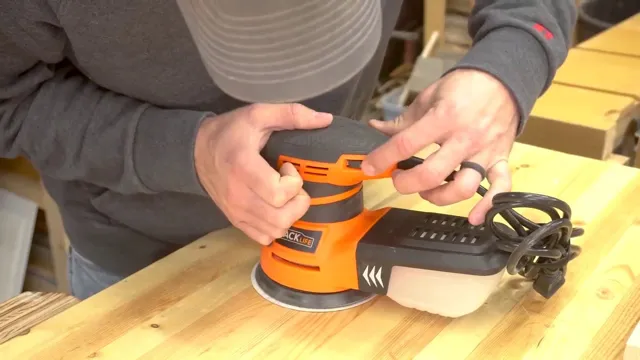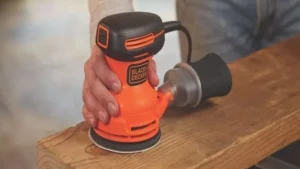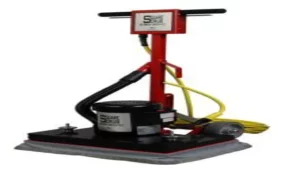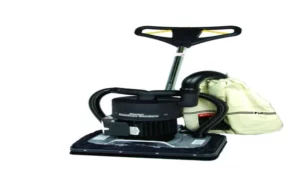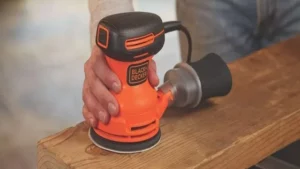Have you ever wondered how an orbital sander works? If you’re a DIY enthusiast or a professional woodworker, then you’re probably familiar with the vital role that an orbital sander plays in your woodworking projects. But for those who don’t know much about this powerful tool, it can be a bit intimidating. An orbital sander is a versatile handheld power tool that uses circular abrasive pads to sand and smooth surfaces such as wood, plastic, and metal.
It’s designed to create consistent scratch patterns on the surface while minimizing swirl marks and other imperfections. The sandpaper on the pad rotates in an orbital motion, which means that it moves in a circular pattern while also rotating around its own axis. This motion creates a random sanding pattern that helps to prevent gouging and ensures a smoother finish.
When using an orbital sander, the operator must apply a moderate amount of pressure and move the sander in a circular pattern while keeping it parallel to the surface being sanded. The speed at which the sander moves will depend on the type of surface being sanded and the grit of the sandpaper being used. In conclusion, an orbital sander is an essential tool for any woodworking project.
Its unique sanding pattern and ease of use make it an ideal choice for both professionals and hobbyists. So, the next time you see an orbital sander in action, you’ll know exactly how it works, and perhaps even try using it yourself!
What is an Orbital Sander?
If you are wondering how an orbital sander works, you’ve come to the right place. An orbital sander is a power tool used for sanding wood or other materials, and it works by vibrating in small circles or orbits at high speeds. It is different from other sanders as it moves not only in a linear direction, but also in a circular motion, giving it the ability to sand a surface evenly and without leaving any noticeable marks.
The round pad of the sander uses sandpaper that can easily be attached, removed, or changed depending on the project’s requirements. The sandpaper grits can be assorted too, depending on the nature of the surface and the desired result. As a result, the sander is versatile and can efficiently complete a range of tasks, from smoothing rough wood surfaces to removing old paint or varnish from cabinets and furniture.
In general, an orbital sander is an essential tool for anyone looking to create smooth, even surfaces for their woodworking projects.
Definition and Features of Orbital Sanders
An orbital sander is a power tool that uses a round sanding disk to smooth out surfaces. These sanders are popular with woodworking professionals and DIY enthusiasts alike because they provide a quick and efficient way to sand wood, metal, and other materials. The sanding disk on an orbital sander rotates in small circles, giving it the distinctive name “orbital.
” This motion allows the sander to remove material evenly without leaving swirl marks or other blemishes on the workpiece. Orbital sanders also come with variable speed settings, which makes them versatile enough to handle a wide range of sanding tasks, from coarse to fine. Overall, orbital sanders are an essential tool for anyone who wants a smooth and finished surface for their projects.

Types of Orbital Sanders
An orbital sander is a power tool used to smooth and sand surfaces. Its circular sanding pad moves in a random orbit, making it ideal for removing paint and wood fibers. There are several types of orbital sanders available in the market, each with its own unique features.
The palm sander is a lightweight sander that is ideal for small DIY projects. It has a square sanding pad, which makes it easy to reach tight corners and edges. Random orbit sanders are ideal for larger projects, such as sanding floors and walls.
They have a round sanding pad that moves in a circular motion, which reduces the chances of leaving swirls on the surface. Belt sanders are the most powerful sanders and are ideal for sanding large surfaces quickly. They have a continuous loop of sandpaper that moves around the drum, which makes them perfect for removing hard-to-reach paint and surfaces.
Whatever your sanding needs may be, there is an orbital sander out there that is perfect for the job.
Working Principle of an Orbital Sander
An orbital sander is the perfect tool for sanding down rough surfaces and achieving a smooth finish on your woodwork. But how does it work? Well, an orbital sander operates by using a circular sanding pad that rotates in an elliptical motion, causing the sandpaper to move in a randomized pattern. This unique sanding pattern is what makes the orbital sander so efficient, as it prevents any discernible sanding marks from appearing on the surface.
Additionally, the oscillating motion of the sander generates less friction and heat, resulting in a longer lifespan for the sandpaper. Most orbital sanders come equipped with a dust collection system, which helps to keep your work area clean, and allows for better visibility as you work. Overall, using an orbital sander can save you plenty of time and energy, making it an excellent choice for both professional woodworkers and DIY enthusiasts alike.
Random Orbital Sanders
Random Orbital Sanders Random orbital sanders are a common power tool used in different industries for smoothing and polishing surfaces. These tools work on the principle of sanding discs moving in a circular motion. The random orbital sander has a unique square-shaped sanding pad, which oscillates in small movements, while the disk rotation spreads the abrasive evenly on the surface.
The sanding action of the sander is random, with no set pattern, and is done to prevent swirl marks and patterns on the final finish. The sanding disc is attached to the sander’s motor spindle via a Velcro-backed pad, and the speed of the motor is controlled by the tool’s speed dial. The random orbital sander has a dust collection system that captures the dust and debris produced during sanding, thereby minimizing the amount of clean-up required.
This innovative tool is efficient, easy to operate, and produces a quality finish that is hard to match with conventional sanding methods. With an excellent random orbital sander, you can easily achieve professional results in no time.
Sheet Orbital Sanders
An orbital sander is a versatile and efficient tool used to smooth or remove material from wood, plastic, metal, or other surfaces. It works by utilizing a circular sanding pad that moves in an elliptical orbit, mimicking the motion of the human hand. This movement pattern allows the sander to avoid leaving any swirl marks on the surface being worked on.
The sanding pad is attached to a motor that rotates it while simultaneously moving it back and forth in a small circular motion. The size and shape of the sanding pad can vary, depending on the type of work being done. A larger pad is suitable for larger surface areas, while a smaller pad is better for intricate details.
The speed of the motor can also be adjusted according to the requirement of the user. Orbital sanders are preferred by woodworkers, carpenters, and DIY enthusiasts as they offer superior results than hand sanding, save time, and reduce fatigue. They are also equipped with dust collection systems that minimize mess and make the sanding process more efficient.
Finishing Orbital Sanders
Orbital sanders are an essential tool when it comes to finishing woodworking projects. These sanders work based on a circular motion, where the sanding pad oscillates in a small orbit while spinning at high speed. The result is a smooth, even finish that is perfect for removing scratch marks left by the previous sandpaper grit.
The orbital sander can make sanding a more efficient process compared to hand sanding, and its portable design enables you to work on large surfaces without experiencing fatigue. You can easily vary the speed of the sander, enabling you to adjust the rate to suit the task at hand. With such an efficient and versatile tool in your arsenal, you can take on even the most challenging projects with confidence.
Parts of An Orbital Sander
If you’ve ever wondered how an orbital sander works, you’re in the right place. It’s a useful power tool that’s designed to make sanding jobs much easier and faster. The sander also provides a smooth finish on wood, paint, or any other material you need to sand.
An orbital sander works by using a sanding disc that rotates in a circular motion while also vibrating back and forth. This motion helps to prevent swirl marks on the surface you’re sanding, and it also increases sanding speed. The sanding disc is attached to a plate that moves in small circles, providing an orbital motion that’s gentle on the surface.
Usually powered by an electric motor, the tool also has a dust collector to minimize the dust that’s created while sanding. The device’s size and shape also allow it to be used in tight spaces and for intricate details. With a good understanding of its parts and how it works, using an orbital sander is a breeze.
Motor, Base and Handle
An orbital sander consists of several parts that work together to create smooth surfaces on various materials. One of these parts is the motor, which powers the sander’s operation and determines its speed and efficiency. The size and power of the motor are crucial factors in determining the effectiveness of an orbital sander.
Additionally, the base is another critical component of the sander. It provides a flat surface to attach sandpaper discs and has a cushioned pad for smooth sanding. The shape of the base also influences the type of jobs the sander can do, like sanding curves or edges.
Finally, the handle is the part of the sander that the user grips to control and maneuver the device. The handle’s design affects the user’s comfort, stability, and control. Overall, knowing these three main parts of an orbital sander can help you understand how the tool works and which features to consider when purchasing one.
Dust Collection System
When it comes to using an orbital sander, it’s important to understand the different parts of the tool and how they work together to achieve optimal results. One crucial component of an orbital sander is the dust collection system. This system is designed to efficiently and effectively remove dust and debris from the sanding surface to improve visibility and prevent damage to the sander.
It consists of a dust bag or collector that connects to the base of the sander, as well as a dust port that is located on the sander itself. Some models may also feature a dust collection adapter that can be connected to a vacuum for enhanced dust removal. By keeping your sander’s dust collection system clean and well-maintained, you can enjoy a safer, more efficient sanding experience.
So the next time you fire up your orbital sander, don’t forget to give the dust collection system some attention!
Using an Orbital Sander
If you’re a DIY enthusiast, you’ve probably heard of an orbital sander. But how does it actually work? An orbital sander uses round sanding pads that spin rapidly in a small orbit to create a fine and even finish on surfaces that need to be smoothed out. This tool is popular for its versatile applications, including refinishing floors, removing paint or rust from metal surfaces, and preparing surfaces for painting or staining.
The key to achieving a smooth surface is the random movement of the sanding pad. This ensures that the sander doesn’t leave marks or swirls on the surface, which can be a problem with other types of sanders. Most orbital sanders also come with a dust collection bag to minimize dust and debris, making it a more pleasant experience to work with.
Overall, an orbital sander is a must-have tool in any DIYer’s arsenal!
Sanding Sheets and Pads
When it comes to using an orbital sander, sanding sheets and pads are crucial tools that you’ll need to get the job done. These come in various sizes, ranging from smaller pads for tight spaces to larger sheets for broader surfaces. Before beginning your sanding project, it’s essential to choose the right sandpaper grit to ensure you achieve the desired result.
Typically, a lower grit number, such as 60 or 80, is suitable for removing rough, uneven surfaces, while higher grit numbers, such as 120 or 150, are better for finishing and smoothing the surface. When attaching the sandpaper to the orbital sander, make sure that it’s fitted securely to prevent it from slipping or flying off during use. By applying even pressure and moving the sander in a circular motion, you’ll be able to achieve a beautifully sanded surface.
Remember to wear protective gear, such as gloves and safety glasses, and work in a well-ventilated area to avoid inhaling dust and debris. With proper use of a sander and sanding sheets and pads, you can complete any sanding project with ease.
Tips for Using an Orbital Sander Safely
Using an orbital sander can be a bit intimidating if you have never used one before. However, with a few safety tips in mind, you can master this tool in no time. Firstly, always wear protective gear such as eye goggles, a face mask, and ear protection.
An orbital sander can produce a lot of dust and noise, which can be harmful to your health. Secondly, make sure that the sandpaper is securely attached to the sander before turning it on. Loose sandpaper can easily fly off and cause injury.
Lastly, start sanding at a slow speed and gradually increase it as you get more comfortable with the tool. Rapid sanding can cause the tool to jump out of your hands, damaging your workpiece or causing injury. Remember these tips and you’ll be able to enjoy the benefits of using an orbital sander.
Conclusion
In summary, it’s no magic trick that the orbital sander works like a charm. With its circular sanding motion and random orbital pattern, it can effectively smooth out any surface with ease. It’s like a skilled magician that can seamlessly make imperfections disappear.
So, whether you’re a DIY enthusiast or a professional woodworker, the orbital sander is an essential tool that can bring life to your projects with a smooth finish. It’s a true workhorse that can handle any task and leave you with nothing but impressive results. Now that’s some serious sanding magic!”
FAQs
What is an orbital sander?
An orbital sander is a power tool that rotates a sanding disc in a circular motion with a random pattern.
How does an orbital sander work?
An orbital sander operates by spinning a sanding disk in small circles while simultaneously moving it forward and backward. The random orbit ensures that no swirl marks or scratches are left on the surface being sanded.
What is the difference between an orbital sander and a belt sander?
An orbital sander is a handheld tool that uses a circular sanding disk, while a belt sander uses a continuous sanding belt. Belt sanders are typically used for heavy-duty sanding tasks, while orbital sanders are better suited for finishing work.
Can an orbital sander be used for woodworking?
Yes, an orbital sander is a versatile tool that can be used for a variety of woodworking tasks, including sanding and finishing.
What grit sandpaper should be used with an orbital sander?
The grit of sandpaper you use with an orbital sander will depend on the project you are working on. For finishing work, a higher grit sandpaper (320-400) should be used, while rougher sanding tasks may require a lower grit sandpaper (60-80).
Is an orbital sander easy to use for beginners?
Yes, an orbital sander is a user-friendly tool that can be easily operated by beginners. However, it is important to use proper safety gear, follow the manufacturer’s instructions, and practice on scrap wood before beginning any project.
What are some common mistakes to avoid when using an orbital sander?
Some common mistakes to avoid when using an orbital sander include applying too much pressure, not sanding evenly, using the wrong grit sandpaper, and not cleaning the surface properly before sanding.
